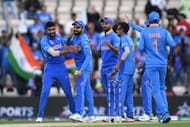
The 2019 Cricket World Cup is in full swing. India have finally played their first game and sent South Africa to the brink of elimination in the process. The tournament has already given us a high-scoring thriller (England vs Pakistan), a medium-scoring thriller (Bangladesh vs New Zealand, a low-scoring thriller (Afghanistan vs Sri Lanka) and several less competitive games.
Particularly interesting has been the domination of bowling. Before the tournament, there were murmurs of a potential 500 score as the likes of England and West Indies threatened batting world records. At the moment, the average innings has been less than half of that. From the fearsome pace of Kagiso Rabada and Matt Henry to the guile of Yuzvendhra Chahal and Mohammad Nabi, bowlers have shown their importance in the modern limited-overs game.
In this bowling resurgence, the role of tactics has been key. To some extent, this should not come as a surprise. The past few years have seen an explosion of analytics in cricket, especially in white-ball formats. Teams have become more knowledgeable of opposition strengths and weaknesses, as they attempt to target opposition batsmen with strategies that make them uncomfortable. This is especially important against destructive lineups like that of England, India and the West Indies.
Thr combination of the analytics revolution and fearsome batting lineups has forced captains to innovate in a manner that has not been seen since Arjuna Ranatunga in 1996 (or even Martin Crowe in 1992). Indeed, this was clear from the very first ball of the World Cup, more on that later.
While some of these tactical tweaks may not work, all of them add an additional layer of intrigue to the World Cup. So what were some of the more successful tactical decisions in the first week of the World Cup?
#5 Virat Kohli's third slip

It may seem like hyperbole to some, but seldom has Indian cricket seen a spell like Jasprit Bumrah's to start off a World Cup. Using quintessentially English conditions perfectly, Bumrah beat the bat with almost every delivery in his opening spell. It only took one delivery to remove a legend like Hashim Amla. At the other end, a world-class batsman like Quinton de Kock could only shake his head as Bumrah beat him time and time again.
Simply put, the young man from Gujarat was unplayable.
Yet, Bumrah's fantastic spell would have only yielded a single wicket if it were not for the aggressive thinking of his captain Virat Kohli. As de Kock struggled, Kohli added a third slip (himself) to the cordon - a rare sight in white-ball cricket. Almost immediately, Kohli's aggression was rewarded as de Kock wafted lazily at a wide ball, resulting in a simple catch for the Indian skipper.
Kohli's decsion to add a third slip not only rewarded Bumrah's brilliant spell, but also removed one of South Africa's best batsmen. According to Ben Jones of CricViz, de Kock's Average Batting Impact (an analytical measure of a batsman's impact on their team's success) is second only to that of Kohli. De Kock may have been struggling, but as Rohit Sharma showed later in the day, an ugly yet effective innings can change matches.
As a captain, Kohli has often (rightly) been accused of being reactive, especially during the IPL. This was the rare occasion where the Indian captain proactively forced an error from the opposition. If he can continue to make similar decisions, then the efforts of Bumrah and Co. will be rewarded.
Also read - Highest strike rate in world cup
#4 Using Imran Tahir against England's openers

While the contest itself was unmemorable, the opening match of the 2019 World Cup has left cricket fans with two unforgettable memories: Ben Stokes' catch and Imran Tahir's celebration after the second ball of the tournament. The latter was made possible by a daring ploy by the South African captain Faf du Plessis. Facing the most destructive opening partnership in ODI cricket, Faf decided to give the ball to Tahir on a green pitch.
Almost immediately, Faf's move, a reminiscent of Martin Crowe's decision to open the bowling with Dipak Patel in the 1992 World Cup, paid off as the experienced leg-spinner took the wicket of the dangerous Jonny Bairstow and set off on one of his trademark runs. It was a moment of true genius by the South African captain, one that threatened to spoil the hosts' party.
Indeed, England "only" made 60 runs in the first powerplay, a relatively low score for them in home conditions. Unfortunately for Faf and the rest of the Proteas, the rest of that match (and the tournament) has not panned out as they would have liked. After three successive losses, they face elimination from the tournament. \
If the South Africans are to save their World Cup and shed the eternal "chokers" tag, one suspects that Faf will have to be similarly brilliant.
#3 West Indies' attacking short-ball strategy

Leading up to the tournament, most of the focus on the West Indies was devoted to their batting. For good reason too, considering how their explosive batting lineup has fired in recent months, such as in the warm up match against New Zealand. In their opening encounter however, it was the West Indian bowling attack that stole the show.
Having left out two of their two best Test bowlers (Kemar Roach and Shannon Gabriel), the rest of the West Indian bowling attack justified their inclusion on a infamous road like Trent Bridge. Like their famed predecessors, the likes of Sheldon Cottrell, Andre Russell, Carlos Brathwaite, Jason Holder and Oshane Thomas dismantled an opposition batting lineup through short balls.
It wasn't quite Fire in Bablyon, but the West Indian decision to attack Pakistani batsmen at their throat was brilliant. It began with Russell, who removed Fakhar Zaman and Haris Sohail with genuinely threatening bouncers. After that, it was a procession as Thomas and Holder took full advantage of Pakistan's weakness against the short ball. The West Indian team management's decision to use the short ball worked brilliantly.
#2 Playing Mohammad Amir and Wahab Riaz

Around a month ago, both Mohammed Amir and Wahab Riaz were not part of Pakistan's preliminary squad for the World Cup. On Monday, there were Pakistan's heroes in a stirring upset for the Men in Green against tournament favorites England. On paper, their contributions weren't exactly impressive. Indeed, figures of 2-67 and 3-82 for Amir and Riaz respectively do not scream "tactical genius".
However, the contribution made by the two experienced pacers against England clearly justified the decision by the team management to include them at the expense of younger options like Usman Shinwari and Shaheen Afridi. On a flat pitch, Amir and Riaz made regular breakthroughs which halted the momentum of England's chase. The latter's scalp of Jonny Bairstow in the powerplay was crucial in removing any momentum that England were starting to enjoy.
But it was at the death where Amir and Riaz really validated the trust shown by Micky Arthur and Sarfaraz Ahmed, even if that trust hasn't always been there. Amir's dismissal of the brilliant Jos Buttler changed the game, just as England's wicket-keeper batsman was threatening to take the game away from Pakistan.
Riaz then sealed the win with a stunning double-strike, as he removed Moeen Ali and Chris Woakes. In a match where bowlers got hammered, Amir and Wahab made the difference for the Men in Green. For that, the Pakistani team management deserves serious credit.
#1 Afghanistan's first-slip against Sri Lanka

Considering the lack of attention on the Afghanistan-Sri Lanka game and the eventual result, Mohammad Nabi's spell is likely to be forgotten fairly quickly. Which is a shame, considering how it flipped the game between the two Asian sides.
Consider this: Sri Lanka were cruising at 144-1 after 21 overs as Kusal Perera and Lahiru Thirmanne threatened to take the game away from Afghanistan. Commentators were openly talking about a possible score over 350 and how the game might help fix Sri Lanka's net run-rate after a horrible opening game against New Zealand.
Afghanistan had other ideas. Nabi first removed Thirimanne, to bring the dangerous Kusal Mendis to the crease. When most captains would have focused on containing two attacking batsmen like Perera and Mendis midway into the innings, Guldabin Naib chose to attack with a slip. It was a risk that many experienced captains with more ferocious bowling attacks would not have been willing to take at that stage in the innings.
Naib's decision to add a slip (Rahmat Shah) worked perfectly. Mendis played for non-existent turn and was caught by the safe hands of Shah. After two balls, the experienced Angelo Mathews made the same mistake and had to pay the same price. After one over, Nabi's guile and Naib's bravery had changed the game completely.
While a batting collapse prevented Afghanistan from scripting a famous victory, Naib's thoughtful aggression gave his team a chance. If the Afghan captain can continue to display similar tactical acumen, then perhaps the team will have more opportunities to spring an upset or two.
Follow IPL Auction 2025 Live Updates, News & Biddings at Sportskeeda. Get the fastest updates on Mega-Auction and cricket news
